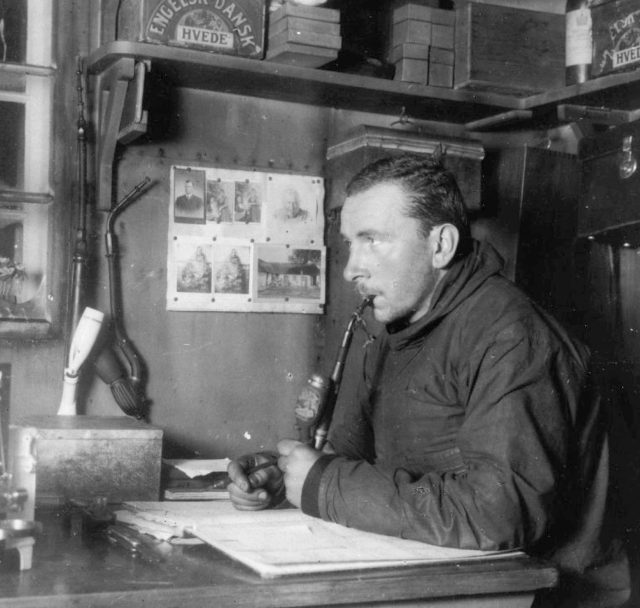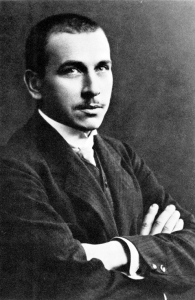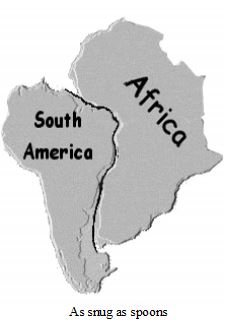
Alfred Wegener, in Greenland, 1930 (photo by Fritz Loewe)
Fifty years ago, we finally figured out why the Earth has mountains. But one hundred years ago, Alfred Wegener had already offered an explanation – it took those extra 50 years for his grand idea to catch on. The continents, Wegener said, wander about. They bump into each other. Accidents cause mountains.
Yea, it’s been a hundred years since Wegener first wrote about continental displacement. A few other people had similar notions earlier. In the 1600s, Francis Bacon speculated that the southern hemisphere’s continents were arranged “like an opening blossom.” Some say Bacon was wondering if they had drifted from an original supercontinent, though Bacon never really said that.
In the 1800s, a few notable geologists (particularly Antonio Snider-Pelligrini, in France, and Richard Owen, in the USA) claimed that the continents were mobile. But their cases weren’t as compelling as Alfred Wegener’s, whose idea was compelling, but also derided, ridiculed, rejected, denounced, smeared, and otherwise not taken too seriously by anyone anywhere. Over the next couple of blog posts, we’ll give Wegener’s theory a bit of an airing.
Alfred Wegener, born November 1, 1880, in Berlin, was the youngest of five children in a middle-class family. His mother, Anna Schwarz, and his father, Richard Wegener, lived in Berlin Mitte, the city’s main centre and cultural and intellectual hub. The elder Wegener taught classical languages and lectured as a theological philosopher. (Some popular histories make much of Wegener’s father, describing him as “an evangelical preacher.” In 1880s Germany, non-Catholic Christians were usually called ‘evangelical‘. The senior Wegener wasn’t a preacher, he taught theology.)
Young Wegener studied at nearby Köllnische Gymnasium, where he ranked first in his school in everything, particularly excelling in physics. Afterwards, he studied in Berlin, then Heidelberg, and Innsbruck. He returned to Berlin’s prestigious Humboldt University where philosopher Walter Benjamin and physicist Max Planck, as well as Albert Einstein, Karl Marx, and Friedrich Engels had all been either instructors or students. During graduate studies, Alfred Wegener assisted at Berlin’s Urania Astronomical Observatory.

30-year-old Alfred Wegener in 1910 (photo credit)
Although armed with a PhD in astronomy, Wegener acquired an interest in climatology. He took a position at the Lindenberg Observatory where his older brother was already a meteorologist. Among other duties, Kurt and Alfred Wegener pioneered weather-balloon tracking of storms. They also tested a new celestial navigation quadrant by climbing aboard experimental balloons. One of their flights, in April 1906, set a record for the longest time anyone had ever been airborne – they spent 52 uninterrupted hours floating above Europe.
Also in 1906, Wegener was invited to join a Danish expedition to Greenland. It was the first of his four field studies on the frozen island. He later regarded the expedition as a turning point in his scientific career – exploring the arctic became his great passion. Greenland offered opportunities for discovery. By the early part of the twentieth century, much of coastal Greenland had been charted, but there were remote unknown stretches along the northeast coast which he explored. The arctic experience tested Wegener’s resolve. His mentor and team leader died during the 1906 expedition while exploring Greenland’s interior by dog sled in conditions similar to those that would later take Wegener’s own life, 20 years later.
 Wegener’s curiosity, and some of his Greenland observations, led him to stray into the unresolved issues of geology. He devoured journals and corresponded widely with geologists. He admits he was seduced by the potential snug fit of the African and South American coastlines. In December 1910, Wegener wrote to his lady friend, “Doesn’t the east coast of South America fit exactly against the west coast of Africa, as if they had once been joined?” (She married the young romantic.)
Wegener’s curiosity, and some of his Greenland observations, led him to stray into the unresolved issues of geology. He devoured journals and corresponded widely with geologists. He admits he was seduced by the potential snug fit of the African and South American coastlines. In December 1910, Wegener wrote to his lady friend, “Doesn’t the east coast of South America fit exactly against the west coast of Africa, as if they had once been joined?” (She married the young romantic.)
After returning from the first of his four Greenland expeditions, Wegener spent the next six years lecturing cosmic physics, applied astronomy, and climatology at the University of Marburg. He was an unusually spirited professor – his students appreciated the small, energetic teacher who presented clear, organized lectures. His course notes were so well-formed that he was able to gather them into one of the first text-books explaining meteorology. His 1911 text became the standard climatology text for several decades and it was the first to include detailed observations and weather data from the Arctic.
As a result of his climate studies, Wegener noted evidence of glacial remains in the Sahara desert and tropical fossils north of the Arctic Circle. Consequently, Wegener developed his idea that the continents are in motion. At first, Wegener claimed, he was unconvinced of his own theory. But in the fall of 1911 he stumbled upon a paper that listed fossil similarities between Africa and South America. Wegener pursued fossil distributions and palaeoclimate evidence. He finally concluded that the continents had split apart, plowed through oceans, and drifted to their present temporary positions. He saw the Earth’s surface as dynamic and alive with motion. He even thought he saw signs of continental drift when he compared his observations in Greenland with maps produced a few generations earlier. On January 6, 1912, Wegener took the risky step of publicizing his unorthodox thoughts about mobile continents.
Tomorrow, we shall see the personal consequences of his continental drift idea and we’ll look at some of the fossils that helped lead him to his conclusion.


Reblogged this on Primate's Progress and commented:
Wegener is not the only scientist for whom meteorology has been the starting point on the path to other major discoveries. It influenced Dalton’s thinking in the development of atomic theory, while writing computer programs for meteorology was Paul Crutzen’s first step towards discovering how CFCs were destroying the ozone layer.
Wegener himself gets a supporting role in the admirable Horrible Science book, “Evolve or Die”
LikeLiked by 1 person
Thanks! It seems that science needs the occasional outsider to shake things up. Meteorologists doing geology? What’s next? Patent clerks doing physics? Thanks also for the Horrible Science suggestion of Evolve or Die. If anyone is interested, it looks like it can be owned for one cent (plus shipping) through Amazon.com!
LikeLike
Does anyone consdier the South African Du Toit writng in the 30s?
LikeLiked by 1 person
Absolutely! Alexander du Toit was the brilliant South African geologist who explored and mapped the Kalahari from his bicycle. But du Toit comes a few years later in our story – he published Our Wandering Continents in 1937. Alex du Toit was a great supporter of Alfred Wegener’s work, picking it up and refining it after Wegener died in 1930. This blog will devote several pieces to du Toit in coming weeks. Meanwhile, we are looking at Alfred Wegener and the events 100 years ago that started the plate tectonics revolution.
LikeLike
I got to know about du toit in South Africa where I wandered around the Namib Desert. I have his book.
LikeLike
Fantastic! I’d love to own a copy of du Toit’s book – I borrowed it through a university library when I wrote my book, The Mountain Mystery, which has a big section about Alexander du Toit’s life and work. In a few weeks, I’ll condense some of that and post it here for you.
LikeLiked by 1 person
In Namib desert i was the third geologist to work there. Fascinating area with late Precambrian tillites
LikeLike
Pingback: 100 Years of Drift: Part 2 | The Mountain Mystery
Pingback: 100 Years of Drift: Part 3 | The Mountain Mystery
Pingback: Wegener’s Death and Drift’s Hiatus | The Mountain Mystery
Pingback: Whewell’s Gazette Year 2, Vol. #31 | Whewell's Ghost